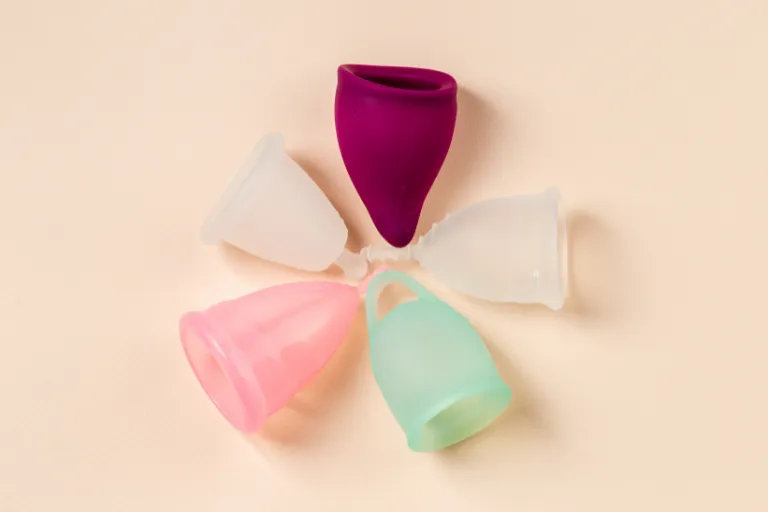Key Points at a Glance
- Top picks: Lena Sensitive, Saalt Soft, AllMatters, Yuuki, MeLuna
- Materials: Medical-grade silicone remains the safest and most biocompatible option
- Fit matters: Sizes, firmness, and stem design vary for different cervix heights, flows, and comfort preferences
- Sustainability: One cup produces less than 1.5% of the environmental waste of disposable options1
- Safety: Studies show low risk of 0 serious adverse events when cups are used properly2
Why This Matters
Each year, an estimated 12 billion pads and 7 billion tampons are discarded globally3. The average menstruating person will use over 9,000 disposables in a lifetime. In contrast, a single menstrual cup can last up to 10 years, offering both a financial and environmental advantage.
Yet despite growing popularity, many still face confusion when choosing a cup: Will it leak? Will it feel uncomfortable? Is it safe? In 2025, the market is more crowded—and more customizable—than ever. This guide filters through the clutter, helping you find a reliable fit backed by science, safety standards, and user experience.
What Makes a Menstrual Cup Stand Out?
1. Material Quality & Safety
Most top-performing menstrual cups are made of medical-grade silicone, a material long used in surgical implants and wearable devices due to its non-reactive, hypoallergenic profile4. To meet international safety benchmarks, these materials are tested under standards like ISO 10993 and USP Class VI, which assess biocompatibility for prolonged internal use5.
Avoid cups that lack third-party safety validation—especially those without FDA registration or European CE-marking for health devices.
2. Comfort, Fit & Flow Compatibility
No two bodies are the same. Some users have a low cervix, requiring shorter cups or “shorty” versions. Others experience heavier flows, necessitating larger-capacity options (up to 40 mL). Firmness also matters: softer cups (like Lena Sensitive) are gentle for those with pelvic sensitivity, while firmer cups offer a stronger seal, which can be helpful for athletes or those with strong pelvic floor muscles6.
3. Ease of Use & Longevity
Insertion, removal, and cleaning should feel easy and natural. Textured stems, grip rings, and clear folding guides can dramatically ease the learning curve. Most cups last 5 to 10 years with proper care, making them more affordable over time7.
📌 Our Top Picks for 2025
| Cup | Best For | Pros | Cons |
| Lena Sensitive | Beginners, low cervix, sensitive anatomy | Ultra-soft, two sizes, simple to fold; recommended by menstrual health educators8 | Lower capacity may not suit heavy flow |
| Saalt Soft | Users prone to discomfort, light to moderate flow | Balanced flexibility, good seal, B Corp sustainability creds9 | Thicker stem may need trimming |
| AllMatters (OrganiCup) | Eco-conscious shoppers | Plastic-free packaging, ISO-certified silicone, solid mid-size fit10 | Some users report occasional suction difficulty |
| Yuuki Soft | Heavy flow, taller cervix | High capacity (up to 38 mL), odor-resistant case included11 | Slightly firm; may not suit those with sensitivity |
| MeLuna | Custom-fit seekers, low cervix | Sizes XS–XL, multiple firmnesses, four stem styles12 | TPE may feel less flexible than silicone for some |
Subscribe for Free for more insightful health articles tailored to your needs.
The Science Behind Menstrual Cup Safety
A 2019 Lancet review analyzing 43 studies and over 3,300 users found no increased risk of infections or tissue damage with menstrual cup use when compared to tampons2. Concerns about toxic shock syndrome (TSS)—while valid—are extremely rare. When cups are emptied every 8–12 hours and sanitized between cycles, risk remains minimal13.Medical-grade silicone and TPE (thermoplastic elastomer) are chemically inert, non-porous, and do not leach endocrine-disrupting chemicals like BPA or phthalates4.
How to Use a Menstrual Cup Safely
- Sterilize at the start of each cycle by boiling for 5–7 minutes
- Wash with fragrance-free soap and water during use
- Empty every 4–12 hours, depending on your flow
- Check your fit—if it feels too high, low, or uncomfortable, adjust the stem or try a new size
- Replace every 5–10 years, or if you notice tears, clouding, or texture changes
Some users report minor bladder pressure or discomfort with firmer cups—this is often resolved by switching to a softer option or trimming the stem6.
What Users & Experts Say
“The Saalt Soft made my period feel invisible—it didn’t leak once and I forgot it was there,” writes one verified Amazon reviewer with a tilted uterus9.
“I started with Lena Sensitive and it was a game-changer. It’s perfect for beginners who don’t want to feel overwhelmed,” says a contributor on Put A Cup In It8.
Dr. Sherry Ross, a gynecologist at Providence Saint John’s Health Center, adds:
“When used correctly, menstrual cups are just as safe—and often more convenient—than tampons. The key is choosing the right fit for your anatomy.”
Tailored Picks by Life Stage & Anatomy
- Beginners & teens: Lena Sensitive, AllMatters Mini
- Postpartum: Yuuki Soft, MeLuna XL
- Athletes & swimmers: Saalt Firm or Yuuki Classic
- Heavy flow: Yuuki Soft, Saalt Large
- Low cervix: MeLuna Shorty, Lena Small
Use fit quizzes from brands like Lena and MeLuna to guide your selection.
Environmental Impact: The Numbers
According to the European Chemicals Agency, menstrual cups reduce landfill waste and greenhouse gas emissions by over 90% compared to pads or tampons1. Brands like AllMatters and Saalt are leading the way in carbon-neutral packaging and product donation initiatives in underserved communities10.
Final Thoughts: Choosing Your Cup in 2025
The best menstrual cup for you is one that suits your anatomy, lifestyle, and comfort—not just your flow. The rise in inclusive sizing, softer designs, and safety-certified materials makes 2025 the ideal time to switch.
If you’re unsure, start with a soft, small cup like Lena Sensitive, and don’t be afraid to try more than one. Like finding the perfect pair of jeans, fit is everything.
Footnotes
- European Silicones Centre. The Menstrual Cup: A Social and Environmental Game Changer. silicones.eu
- van Eijk AM et al. Menstrual cup use, leakage, acceptability, safety, and availability: a systematic review and meta-analysis. The Lancet Public Health, 2019
- MedlinePlus. Menstrual hygiene products: Environmental impact. U.S. National Library of Medicine
- Newtop Silicone. Is Silicone Safe for Menstrual Cups? newtopsilicone.com
- Besukhi Biotech. Understanding USP Class VI and ISO 10993 standards. besukhi.com
- Best Reviews. Best Menstrual Cups of 2025. bestreviews.com
- Health.com. How Long Do Menstrual Cups Last? health.com
- Rosas K, Hearn A. Put A Cup In It: Cup Reviews. putacupinit.com
- Tembe Denton-Hurst. The Best Menstrual Cups, According to Experts. The Strategist (New York Magazine), 2025.
- AllMatters. Sustainability & Social Impact. allmatters.com
- Yuuki Cup Official Site. Cup Sizes and Features. yuuki.cz
- MeLuna USA. Choosing Your Cup. meluna-usa.com
- ScienceDirect. Toxic Shock Syndrome and Menstrual Devices. sciencedirect.com
The article does not in any way constitute as medical advice. Please seek consultation with a licensed medical professional before starting any treatment. This website may receive commissions from the links or products mentioned in this article.
Subscribe for Free for more insightful health articles tailored to your needs.




